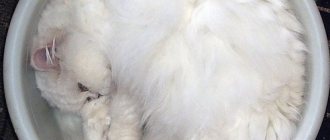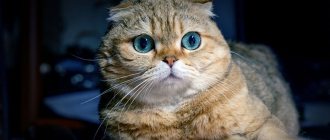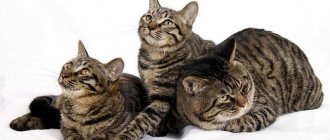Appearance of a golden cat
Its length is 72-94 cm. Weight is 11-14 kg.
The African golden cat is smaller than the Asian golden cat.
The African golden cat is a very slender predator. Her ears are rounded, dark outside, her head is small, her paws are high. The front legs are shorter than the hind legs, so when the golden cat is in a hurry, it moves in large leaps, pushing off with its hind legs and jumping on its front legs.
The tail is long, accounting for up to 1/3 of the total body length.
The color of the golden cat is very diverse: red, chestnut-brown, silver-gray, gray-brown, brown, bluish-gray, and there are even black individuals. The pattern on the upper side of the body is the same color as the main color, only a little darker. The inside of the legs, chest, belly, cheeks and chin are white, the throat and underside of the tail are lightly colored. There are two blackish stripes on the cheeks. The golden cat has large black spots on its belly. Narrow transverse stripes composed of small specks are visible on the chest and throat. There are wide transverse stripes on the inside of the legs. A light border is usually visible around the eyes.
There are two varieties of golden African cats: in the western, coastal, the pattern on the coat is more noticeable; The inhabitants of the interior of Africa have darker fur, especially on the head. Therefore, the pattern sometimes becomes indistinguishable. However, one variety smoothly transitions into another.
Description and natural habitat
Temminka was originally classified as a member of the golden cat family, but today this classification has been abolished. The beast is considered and is a descendant of Kalimantan or Barneo cats.
This is a fairly large animal, at least twice the size of a regular domestic cat. The average length from the nose to the tip of the tail is 90-95 cm. A strong muscular body with powerful paws is covered with thick short hair of brown or golden shades, although there are also melanistic cats in natural gray or black tones. The color is more of a tabby, although the golden hairs are ticked. The body may have sparse spots and streaks, and the muzzle has characteristic charcoal-white stripes.
The natural range of this animal is quite wide - from the foot of the Himalayas to the southern edges of the Chinese border and the Indochina Peninsula, although some species are also found in Sumatra. For the most part, this species inhabits mountain forest biotopes. The Temminka cat can be found in the subtropical and tropical zones of evergreen forests of the following countries - Thailand, Nepal, Malaysia, Bangladesh, Myanmar, India, Bhutan, Vietnam, Laos, Cambodia.
Sometimes this wild cat also appears on coffee plantations and open forest areas.
Depending on the region where it lives, the size of the Temminka Cat varies greatly. The smallest specimens barely reach 60 cm in length, and the largest ones are more than a meter. Height at the withers is from 35 to 55 cm. Weight ranges from 10 to 17 kg.
The head is not particularly large compared to the powerful body with fairly long and strong legs.
The eyes are not too large and not very wide apart. They are often brownish or golden in color. The nose is wide and large with a large, brick-colored nose.
The ears are medium in size with slightly rounded tips and set quite high.
The tail is long, up to 50 cm, wide at the base and slightly tapering to a rounded tip.
The coat is short, dense and hard, the skin has well-developed sebaceous glands. Therefore, each hair is covered with a layer of lubricant, which protects the animal in mountainous areas from overheating and hypothermia during sudden temperature changes.
If we talk about the most common natural color, the general background color can be described as golden yellow or reddish. The mask on the face, characteristic of any predator of the feline order, makes the Temminka Cat a very expressive and bright animal due to the black and white clear lines that run along the cheeks, earpieces, forehead, and encircle the eyes.
The chest, abdominal area, inner side of the paws are of a lighter, almost beige shade, more like “coffee with milk”.
A dark brown stripe runs along the back to the tip of the tail.
In the rays of the sun, the animal’s fur actually shimmers, as if drenched in molten gold, which is why the animal is called the Fire Cat.
Lifestyle and nutrition of a golden cat
The golden cat is nocturnal. It hunts in the dark and rests during the day. Nature generously rewarded the golden cat for its nocturnal lifestyle. She has excellent hearing, sharp eyesight, and a keen sense of smell. The golden cat can sneak up completely silently on such sensitive creatures as mountain birds, antelopes or wild goats. And more mature and experienced African golden cats dare to hunt even wild buffalos.
The golden cat leads a solitary life, like almost all wild cats (only lions live in prides). She's a typical predator. It feeds exclusively on animal food: rodents, birds, small antelopes, monkeys. Does not disdain the remains of the eagles' prey. The golden cat roams in search of food over a fairly large area. A fellow tribesman who accidentally wanders into someone else's living space is expelled quickly and decisively. The African Golden Cat has an unpleasant body odor and the smell of her feces.
Golden Asian cat
The Asian golden cat, or Gemmincki cat (Catopuma temmincki) is the same size as the African golden cat, although somewhat heavier (there are cats weighing 11-16 kg, although the average weight of animals is 8-11 kg, and according to other sources 4.2 -7.75 kg). The length from the nose to the tip of the tail is 75-105 cm, according to other sources, the length of the body including the head is 77.5-87.5 cm, the tail is 47.5-50 cm. This is a medium-sized cat, proportionally built, whose dimensions are twice that of a domestic cat . The ears are short and round. The coat color is rich golden, sometimes reddish-golden, lightening to white on the sides and belly. Sometimes there are gray individuals. Some animals have no spotting, while others have clearly visible light brown spots. There are individuals that are dark brown, almost black. There are distinct gray spots behind the ears. Between the eyes there is a white stripe with a black border that goes to the top of the head. The Asian cat lives in the forests and mountains of southeast Asia: southern China, Burma, Thailand, Vietnam, Cambodia, Malaysia, Nepal and Tibet, from the Himalayas to the Malay Peninsula. Hunts during the day, on the ground, for prey of all types up to the size of a small deer, including hares, goats and lambs. They often hunt birds. They can climb trees well. Breeding begins at the beginning of winter; 1-3 kittens are born in February after a pregnancy of 75 days. They make dens in tree hollows.
There are the following varieties of golden Asian cat: Golden Asian cat (Catopuma temmincki temmincki) - lives in the Himalayas to Sumatra; Golden Asian cat (Catopuma temmnicki dominicanorum) - common in southern China; Asian golden cat (Catopuma temmnicki tristis) - found in the southwestern Chinese highlands.
Golden cat breeding
During the breeding season, golden cats form a pair. For childbirth, the female makes a den in thickets of vegetation, in hollow trees, crevices or cracks in rocks.
The female brings 1-2 blind kittens. Kittens' eyes open at 6-7 days. Lactation lasts up to 7-14 weeks, stopping when the kittens weigh 2.5-3 kilograms. Male golden cats do not take part in feeding and raising kittens. They live completely separately from their family.
Reproduction and care of offspring
Usually there are 2-3 kittens in a litter of an African golden cat.
The onset of puberty occurs at 11-18 months of life, earlier in females. During the mating season they form pairs.
A couple can stay together for the period of raising offspring. The male participates in raising the offspring along with the female.
The female carefully selects a secluded place for the birth of kittens. These can be vegetation thickets, crevices in rocks, hollow trees.
- Pregnancy: 75-80 days.
- Number of kittens in the litter: 2-3.
- Weight of a newborn kitten: 180-250 g.
- Breastfeeding: 6-8 weeks.
Cubs are born blind, open their eyes at 6-8 days, and by 10 days they begin to move independently. Kittens develop very quickly; males develop faster than females.
From 38-40 days of life, the cubs begin to eat meat. The female does not leave the cubs until they reach sexual maturity - up to 18 months. The lifespan of an animal in captivity is 12-15 years.
Population status and protection of the golden cat
The current population of golden cats (1996 estimates) is estimated at 10,000 adults, with no subpopulation containing more than 1,000. The main threat to the golden cat is deforestation in Equatorial Africa. Golden cats are prohibited from being hunted or hunting is restricted in all range countries.
However, the local Negroid pygmy population believes that the tail of the golden African cat brings good luck during hunting. Cat skins are used as ritual clothing.
Golden Beast from the Rainforest
It is no coincidence that this African wild cat was called golden, and this is not only because of the bright red fur of the animal, sparkling like polished gold. In the cat family, this interesting animal is rightfully considered one of the rarest, most mysterious and least studied, and local residents endow it with magical properties.
Very little is still known about the life of the golden cat in nature.
Golden or golden?
Two remarkably similar animals - the Asian golden cat (Pardofelis temminckii) and the African golden cat (Profelis aurata) - live, as their names suggest, in Southeast Asia and Equatorial Africa. External similarity, like the similarity of names, periodically provokes considerable confusion. Both cats are sometimes called golden, sometimes golden, sometimes also called fire cats, and the Asian cat has another name - Temminka.
Asian golden cat - not to be confused with the African golden cat
These are completely different species - one can only assume that they turned out to be so similar as a result of similar conditions for evolutionary development, because both species formed in hot tropical forests, where there is a lot of rainfall.
The African is closely related not to the golden Asian, but to other species of cats - servals and caracals. So close that some scientists propose combining the caracal and the African golden cat into one genus.
The African golden cat is a close relative of the caracal.
Habitat and relationships with humans
A significant part of the African golden cat population has settled along the banks of the Congo River in tropical rainforests; the predator lives in various countries of Equatorial Africa: Angola, Kenya, Uganda, Senegal. Representatives of this species are found not only on the plains, but also quite high in the mountains - up to 4 thousand kilometers above sea level.
The habitat of the golden cat is Equatorial Africa, central and western regions
In recent years, tropical forests have been actively developed by humans - they are cut down and burned for agricultural land, and this has a very negative impact on the size of the wild cat population, which is deprived of its habitat. For its part, this proud predator tries to interact with people as little as possible and almost never approaches a human home, not to mention stealing domestic animals for food.
Golden cat tries not to catch the eye of a person
Local residents - mostly pygmies - hunt the animal for ritual and commercial purposes. Aborigines know a lot of mystical stories and legends about the golden cat, sincerely believe in the magical power of its body parts and make talismans from them. For example, in their opinion, the tail of an animal promotes successful hunting of elephants; a necklace of fangs or claws protects against evil forces and diseases. And African priests always use cat skins for ritual clothing. Exotic talismans are in demand among tourists, which again stimulates the natives to exterminate the golden cat.
When going hunting, pygmies hang themselves with the tails of wild cats.
The number of this rare animal is most likely decreasing - research on this matter is very difficult, since the animal leads a secretive lifestyle and avoids humans in every possible way. The last calculations were carried out quite a long time ago, in 1996; then scientists estimated the total population of the African golden cat at only ten thousand adult sexually mature individuals. The latest, less accurate study was carried out in 2011 - according to its data, the population of the species decreased by a thousand individuals.
Number of species
The number of African black-footed cats according to the CFA (Cat Fanciers' Association) is extremely small. The number of wild individuals has not been calculated even approximately. There are only 40 such animals in all zoos in the world, of which 19 are in the United States.
The number of black-footed cats is very small
There is no targeted hunting for this species, but animals die accidentally as a result of falling into traps set for other predatory animals. Hybridization with domestic cats also threatens the natural population. The degradation of the species was caused by environmental reasons and changes in the natural environment. However, a special program has been developed for breeding the African spotted cat in captivity, which is supported by several zoos. Over time, biologists expect to increase the number of animals and gradually restore the population.
Servals, like other exotic animals, are targeted by poachers. Firstly, the fur of spotted cats is always in demand. And secondly, Africans hunt cats for their meat. In addition, predators are exterminated due to attacks on poultry. For these reasons, the number of the species is declining every year.
Serial is a medium-sized African wild cat. Servals lead a predominantly crepuscular lifestyle, feeding on small animals. Servals are smart and inquisitive. They are capable of remembering and learning, which is why people learned to domesticate these cats.
Life of an African black-footed cat in captivity
The serval is a small, wild mammal of the wild cat family. The Serval comes from Africa. The Latin name of the species is Felis serval or Leptailurus serval (bush cat). Because of their appearance, servals are considered relatives of the caracal and steppe lynx.
Serval is an African wild cat
The history of the species dates back more than one millennium. Back in Ancient Egypt, servals, along with other wild cats, saved civilization from a rodent invasion. Then the serval was taken for a sacred animal. But modern domestication of these cats began in the 19th century. Servals began to be domesticated in Europe. For many years, people have tried to breed serval hybrids with representatives of other species. Because of this, the number of servals has decreased significantly. The species has several subspecies:
- Leptailurus serval serval - from Tanzania to the former Cape Province (South Africa).
- Leptailurus serval beirae - Mozambique.
- Leptailurus serval brachyura - West Africa, Sahel, Ethiopia.
- Leptailurus serval constantina - North Africa (endangered).
- Leptailurus serval hamiltoni - east of the former Transvaal province (South Africa).
- Leptailurus serval hindeio - Tanzania.
- Leptailurus serval ingridi - Namibia, southern Botswana, Zimbabwe.
- Leptailurus serval kempi - Uganda.
- Leptailurus serval kivuensis - DR Congo.
- Leptailurus serval liposticta - northern Angola.
- Leptailurus serval lonnbergi - southern Angola.
- Leptailurus serval mababiensis - northern Botswana.
- Leptailurus serval robertsi - west of the former Transvaal province (South Africa).
- Leptailurus serval togoensis - Togo, Benin.
The difference between the subspecies is the color. The division of subspecies is determined by the habitat. In general, the species inhabits different countries in Africa. And due to natural barriers (deserts, thickets of trees, reservoirs), the subspecies do not interbreed. Thus, the appearance of different subspecies of servals has stable features.
servals with a large number of small spots are often confused with cats of other species; black servals are called melanists (in fact, there are spots on the body of such a cat, but their color is barely distinguishable) servals with a cheetah pattern are most common; albino servals are found in nature; extremely rare white servals with gray spots - this is the achievement of breeders
Some breeders recommend keeping the serval only in a private home. After all, in the courtyard of the house you can organize an aviary of any size. This is due to the fact that the animal needs to actively move, and this is impossible to do in an apartment. But there is another opinion. In enclosures, the wild nature of the predator is preserved throughout its life; in such conditions, servals are kept only for the purpose of breeding (for example, if the purpose of keeping a cat is to breed kittens for sale).
It is not known for certain how long these cats have existed; historical chronicles do not keep any records about them. But the breed was first described in 1824. The scientific species name is Felis nigripes (lat.). The animal was named black-footed because of the characteristic coloring of its limbs, which in fact are not completely black. Only the lower parts of the paws (feet), including the pads, have this color.
In fact, the cat’s legs are not black, the lower surfaces of the paws and pads are that color.
Unofficially, these rare predators are called ant tigers. This may be because they like to make their lairs in empty termite mounds and abandoned old burrows of porcupines, rabbits, aardvarks and striders. And the coloration of the cats resembles the king of beasts.
Keeping a wild African spotted cat in captivity is quite difficult. It is believed that this animal can be domesticated, but it will never be completely tamed. Small predators are naturally suspicious and extremely wary of people. Being a prominent representative of wild fauna and a ruthless and ferocious hunter, a cat cannot forget its instincts even with the most competent upbringing and good training. It rarely becomes attached to its owner.
Black-footed cats are bred in specialized nurseries
These solitary animals are extremely uncooperative and will not tolerate other pets in the house. They strive for solitude and loneliness, so you can always expect a surge of aggression and sudden changes in mood from them. This temperamental hunter will definitely not become compliant and tame.
Features of care
For a comfortable existence, a black-footed cat must be provided with a spacious enclosure, which must be equipped with a large number of elements and objects that make the space inside similar to the conditions of the savannah. You need to pour a thick layer of sand on the floor. It is recommended to design one of the walls in the form of rocky ledges and ladders on which the pet can climb.
Everywhere you need to place stones of different sizes and wooden logs. It is necessary to provide for the presence of vegetation (shrubs and grass) and provide good lighting. There should be enough space for the unhindered and free movement of the little hunter, as well as for his active movement, games and rest.
To keep a black-footed cat in captivity you need a spacious enclosure
The diet deserves the closest attention. Feeding a wild animal prepared animal food is completely unacceptable.
The menu of an African spotted cat must include:
- fresh quality meat;
- offal;
- veins, bones and cartilage (to obtain the necessary nutrients and proper development of the jaw muscles);
- dairy products;
- fish.
In addition, your pet will need to regularly receive the necessary vaccinations and periodically show it to the veterinarian.
From personal experience. It is better not to try to pull wild animals out of their usual habitat. Even being kept in a zoo, which can afford to create very good living conditions and provide adequate nutrition, is unusual for non-domesticated pets. There are many breeds of cute domestic cats whose appearance and easy-going nature will suit anyone. There are also more obstinate individuals for those who are not looking for easy ways.
At home and in the zoo, black-footed miniature cats live up to 10–12 years.
There are special nurseries where spotted African cats are bred. This is the only place you should buy this little predator. Breeders cross wild cats with domestic cats to produce hybrids that produce offspring with a striking exotic appearance and a more docile, loyal disposition. The cost of such an exclusive kitten can exceed 10–12 thousand dollars.
A black-footed kitten can be purchased at a specialized nursery











